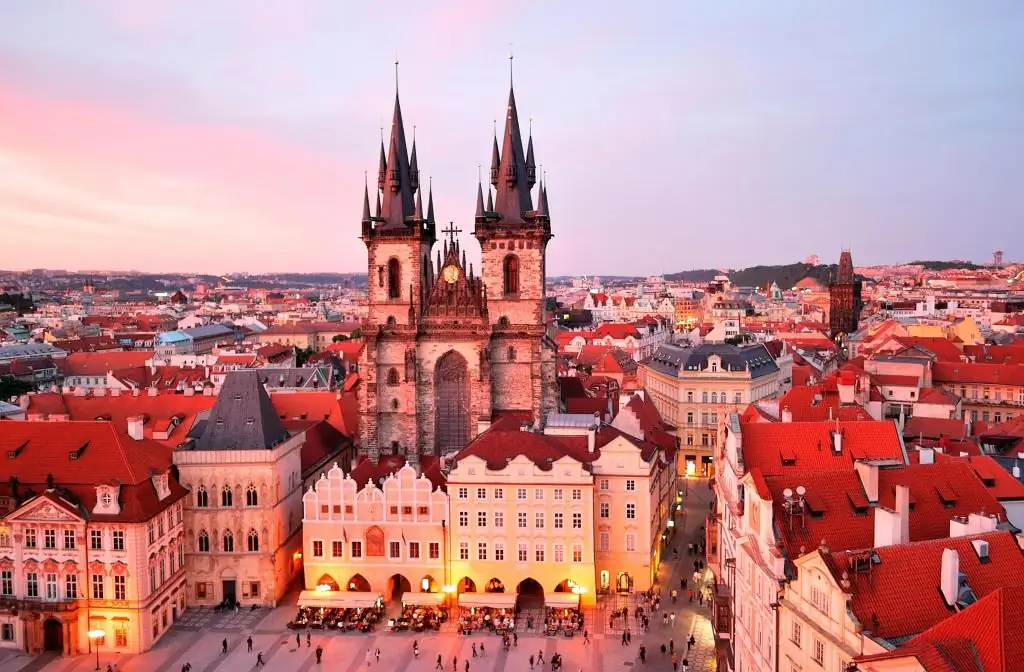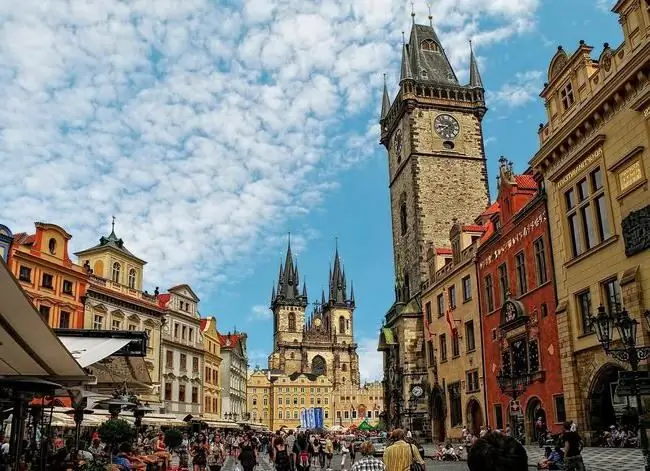- Author Harold Hamphrey [email protected].
- Public 2023-12-17 10:06.
- Last modified 2025-01-24 11:10.
If you are going on a trip to Europe and are thinking about what to see in Prague on your own, then Clementinum should become a must-see in terms of visiting attractions. Of course, this place is not included in the excursions in Prague in Russian, but even with Russian-language booklets in your hands, you will be greatly impressed by what you see. To get started, you can familiarize yourself with the Clementinum in absentia.
Pearl of Prague

Charles Bridge, Old Town Hall, Tyn Palace - all these wonderful architectural monuments are undoubtedly associated with the amazingly beautiful capital of the Czech Republic. But no description of the sights of Prague can do without a unique architectural complex, a wonderful example of the magnificent baroque style, proudly located in the center of the historic city, not far from the Charles Bridge. We are talking about Clementinum, the famous temple of science andart created centuries ago by the enigmatic Jesuits.
Stronghold of the Jesuits
In the middle of the 16th century, representatives of the famous Jesuit order appeared in Prague with the light hand of Ferdinand I, who were supposed to assist him in confronting the Reformation. Their home was the former Dominican monastery of St. Clement, built in the 11th century near the Charles Bridge in the Old Town. It was here that the members of the fraternity founded the Jesuit College, which became one of the largest of its kind.
The Jesuits, striving for the widespread spread of the Catholic religion, rapidly grew rich and increased their power. They turned a small monastery into a grandiose complex of baroque buildings, unsurpassed in their beauty and grandeur. The construction boom continued from 1622 until the middle of the 18th century. Clementinum flourished along with the Jesuit order.
In 1622, the Clementinum and Charles University, considered one of the most significant educational institutions in the Czech Republic, were reunited by the Jesuits. Together, colossal libraries were formed, for which a separate building was built.
From 1654, the newly-founded university was called Carlo-Ferdinand University, until it was divided into Czech and German in the 19th century.
What is included in the Prague Clementinum complex?
Clementinum in Prague has changed many times. More and more new halls and churches were built, magnificent gardens were planted. But this complex has survived to this day in excellent condition and is now the most interesting example of the late Baroque,second in scale after another grandiose historical complex - Prague Castle.
Lovers of history, architecture and art must visit the following places here:
- Mirror chapel.
- University Library.
- Astronomy tower.
- Christ the Savior Church.
- Mathematical Museum.
- Meridian room.
Due to the fact that there are very few excursions in Russian in Prague, each tourist is given a booklet in his native language. And even in these circumstances, the beauty, richness and grace of the ancient premises will not diminish at all.
Capella of the Virgin Mary
The Mirror Chapel, built in 1724, is an amazing combination of an ancient religious symbol and a magnificent concert hall.

The chapel got its name for the interior decoration. The walls of the architectural masterpiece are lined with mirrors from floor to ceiling, while the hemispherical ceiling stucco also contains mirror elements that reflect the stars of the magnificent marble floor. All this creates an incomparable feeling of infinity and lightness of space.
Beautiful frescoes on the ceiling are dedicated to biblical events related to the Annunciation of the Virgin. Previously, in the depths of the chapel there was a rich altar, which currently replaces the organ of the ancient work of the late 18th century. The chapel has another organ located closer to the entrance. The age of this extraordinarymusical instrument is even more respectable, because it was created by masters at the end of the eighteenth century. He is also famous for the fact that he remembers the great Mozart, who played this instrument during his stay in Prague.
Due to its unsurpassed acoustic properties, the chapel has become a venue for classical music concerts. The uniqueness of the chapel lies also in the fact that two organs in it can sound absolutely in unison, which is rare for such instruments.
Temple of Science and Art
Reorganized by the Jesuit monks, now the National Library of the Czech Republic is a place that simply cannot be ignored when talking about Prague's Clementinum.
The building of this unique library, the pearl of the Czech Republic, was erected in 1727. Currently, the library fund has hundreds of thousands of priceless books, including handwritten ones. Floor-to-ceiling bookshelves are literally bursting with an abundance of precious volumes, most of which are written in Latin, German and Italian.
The ceiling of the hall is decorated with elaborate frescoes symbolizing Science and Art. In the very center of the ceiling is the famous Temple of Wisdom fresco by Joseph Diebel.

Also, the book hall is notable for its collection of ancient rare globes, geographic and starry sky maps created by the Jesuits. Unfortunately, it is not possible to consider them in detail due to the limited access tohall.
Of course, the rarest folios are available only to specialists, and then with individual permission, but the Clementinum in Prague is also equipped with a reading room, immersing its visitors in the unforgettable atmosphere of the 18th century baroque.
Visegrad Codex
And even though you won't be able to look through a copy of an old book in the book hall of the library, you shouldn't be upset. In a small foyer preceding the hall with books, an exact copy of the rarest manuscript of the 11th century - the Visegrad Codex is exhibited especially for lovers of antiquity.

The Visegrad Code (also called the Coronation Code), created in 1086, is dedicated to the enthronement of the first Czech king, Vratislav II. One of the rarest and most valuable manuscripts in the Czech Republic is a collection of gospels and theological texts. The significance of this manuscript is so great that it has been insured for 1 billion crowns.
Clementinum in Prague - just a storehouse of historical rarities found everywhere here. So, next to the Visegrad Codex, in the foyer of the library, you can see the famous Kepler's astronomical instrument - a sextant that helped the scientist in his scientific research.
Astronomy tower
If you are still looking for something to see in Prague on your own, then, without a doubt, go to the Clementinum Astronomical Tower.

The tower was built in 1723 by order of Chancellor Frantisek Retz. At the top of its dome flaunts the figure of Atlanta withcelestial sphere in hands. From the middle of the 18th century, it acquired the status of an observatory and became a center for astronomical, meteorological and mathematical research. There is a curious exposition of telescopes, mathematical and astronomical instruments. One of the highlights of Prague's Clementinum and the Astronomical Tower is an old-fashioned hourglass that is still perfectly accurate.
In 1928, astronomical research began to be carried out in a new observatory, and since 1939, only meteorological observations relevant to modern Central Europe have been recorded in the tower.
The observation deck of the tower, located at a height of 50 m, is a real find for visitors. Climbing here along a narrow spiral staircase, you can contemplate a beautiful view of the historical center of Prague, located in full view.
Unfortunately, in the last decades of the last century, the Astronomy Tower was closed to tourists. Only in 2000, the architectural monument of the 18th century, which has come down to us in its original form, was cleared of rubbish and rodents and is again available for visiting.
Meridian room
On the Old Town Square, not far from the monument to Jan Hus, there is a paved line that differs from the paving of the rest of the square. This is the Prague meridian. The fact is that at astronomical noon the shadow from a column located not far from this line falls exactly on it. This was the notification of the townspeople about the onset of noon.

The room is named after this meridianin one of the towers of Clementinum. Only its prototype here is a string stretched across the whole room. As soon as noon comes, a ray of sunlight, peering through a tiny hole in the wall, crosses this string. This served as a signal to notify the townspeople about the onset of noon. Until 1918, this honorable mission was carried out by a turret cannon by means of a shot, and later they simply signaled from the turret, waving a flag.
Church of the Holy Savior

During the heyday of the Jesuit order, this most valuable architectural monument of the early Baroque was considered the main temple of the Order. It was built on the site of a former Dominican monastery.
What trials the church had to endure! During the Hussite uprising, it was burned to the ground, and then restored by the we althy Jesuits. The greatest architects and artists participated in its long construction and decoration: Carlo Lurago, Francesco Caratti, Giovanni Bartolomeo Cometa and many others.
Before entering the church, tourists are greeted by an artistic colonnade painted by the unsurpassed Giovanni Cometa, and skillful statues of the church fathers, the saints of the Jesuit order, Christ and the Virgin Mary are greeted from the portico. Artistic plaster and confessionals, decorated with statues of the 12 apostles, amaze with their elegance and beauty.
It also hosts excellent organ concerts, which are appreciated not only by local residents, but also by numerous tourists.
Curious facts
I wonder ifwhat:
- Several centuries ago, a Jesuit named Conias burned 30,000 volumes of books in the local library that were considered "heretical".
- According to legend, the Jesuits arrived in the city with a single book and only then collected a huge library fund.
- In 2005, the Clementinum Library received a special UNESCO Prize "Memory of the World".
- A small portion of the old manuscripts was provided by Google to be scanned and made freely available on Google Books.
- Since January 2017, the Clementinum has been closed for extensive restoration for 2 years.






